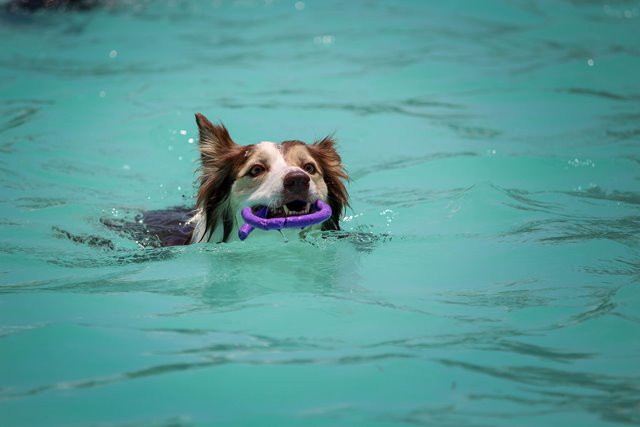Hydrotherapy and physiotherapy
Hydrotherapy and physiotherapy for dogs and cats If you’ve ever had any sort of joint, muscle, or nerve injury then you’ll likely be familiar with physiotherapy, which can be an excellent tool to aid recovery from these kinds of problems. What you may not know however, is that similar treatment options are also available for […]
Hydrotherapy and physiotherapy for dogs and cats
If you’ve ever had any sort of joint, muscle, or nerve injury then you’ll likely be familiar with physiotherapy, which can be an excellent tool to aid recovery from these kinds of problems. What you may not know however, is that similar treatment options are also available for your pets! Here we’ll cover some basic information about the different types and uses of physiotherapy in dogs and cats, and will then focus on a particularly popular type of treatment, hydrotherapy.
Uses of Physiotherapy
Physiotherapy is a type of treatment which can help to strengthen muscles, improve mobility, and ultimately help a patient return to normal function more quickly. It can be applied in many different situations, for example:
- Post orthopaedic or spinal surgery
- Stiffness due to arthritis
- After soft tissue injuries (ligament/tendon ruptures/strains)
- Muscle atrophy
- Nerve or joint damage
Types of Physiotherapy
The term physiotherapy actually refers to a wide range of different treatment types. This can include:
Massage: As in people, massage helps to warm up the muscles and also encourages normal circulation. This is often performed at the start of a physio session to increase mobility, allowing for a greater range of motion for later exercises.
Stretching: Similarly, passive stretching of muscles through their full range of motion improves circulation, and further increases flexibility.
Assisted standing and walking: Many animals referred for physiotherapy will have experienced some period of immobility/disuse of their limb or limbs. Not only will this lead to weakening of the major muscles of the limb in question, but it will also affect their general core stability. Assisted standing or walking allows an animal to begin to regain this stability and strength, without placing undue forces on the injured limb(s). Various pieces of equipment can be used to increase the difficulty level of these exercises, including gym balls, wobble boards, and resistance bands.
Laser and shockwave: Various newer treatment modalities have gained popularity recently, including laser treatment and shockwave therapy which are claimed to accelerate healing and reduce pain and inflammation. Laser treatment involves the application of light energy to damaged tissue, and is usually well-tolerated in the conscious patient. Shockwave therapy on the other hand uses high energy pulses directed into the tissue, which can be quite uncomfortable. For this reason, most patients require sedation or anaesthesia for this treatment.
Hydrotherapy
One particularly popular form of physiotherapy is hydrotherapy, which refers to specific types of treatment that are performed in water. Carrying out the treatment underwater has several benefits, including:
- Warm water can help to warm up the muscles, relieving pain and tightness and reducing muscle spasm
- The water acts to effectively reduce the patient’s weight. This not only means that the patient is easily supported for any stretching/mobilisation work, but also allows cardiovascular fitness to be improved without placing unnecessary force through any damaged joint(s)
- Lastly, the hydrostatic force of the water provides natural compression to the joints, which can reduce swelling
In general, hydrotherapy takes two forms:
Hydrotherapy Pool: During these sessions, patients are given a life jacket and then gently introduced to the water. Often sessions begin with some passive stretching and massage, and as mentioned above, these are made much easier by the buoyancy of the animal in the water. Your pet can then be encouraged to perform some more strenuous exercises such as laps of the pool, but this will be adapted by the therapist according to each animal’s specific needs.
Water Treadmill: Though it may look a little strange, the underwater treadmill is an extremely useful piece of equipment for hydrotherapists. The design is similar to a regular treadmill but it is enclosed on all four sides by clear glass walls to form a watertight box. Once the patient is standing on the treadmill, the walls are closed and sealed, and the chamber begins to fill with water. The more water that is added, the more buoyant the patient becomes and thus the more weight is taken off their joints. This makes hydrotherapy an excellent tool not only for rehabilitation, but also for overweight animals that need to lose weight but whose activity is restricted by joint pain. The speed of the treadmill and the length of the session can be adjusted, allowing the hydrotherapist to tailor each session specifically to your animal to achieve the desired results.
Common FAQs
‘But my dog is scared of water!’ – While some dogs are natural swimmers, it’s not unusual for some to be a little nervous at first. Fortunately, hydrotherapists deal with these animals every day, and are experts at convincing even the most petrified pooches to give it a go. A combination of treats and gentle encouragement usually does the trick, and remember that owners can also be present for the session, to provide a calming influence and help get things going.
‘What about cats?’ – While most cats aren’t natural water lovers, most hydrotherapists will take on feline patients, and many cats become very comfortable in the water after only a few sessions. With this said, some cats will be unable to tolerate hydrotherapy, and in these cases it would be better to consider different types of treatment.
‘How can I get physiotherapy or hydrotherapy for my pet?’ – The easiest way to get physiotherapy or hydrotherapy for your pet is through a referral from your vet. In this case your vet will be able to pass on details about your animal’s history, and make specific recommendations about the kind of treatment required. However, if you would rather arrange treatment yourself, then many hydro/physio centres are happy to be contacted directly by pet owners.
Hopefully, this information has provided a useful introduction to the different types of physiotherapy and the potential benefits of this kind of treatment. If you think that physiotherapy could help your pet, your vet will be able to give further information and advise you on what kind of treatment may be appropriate.



